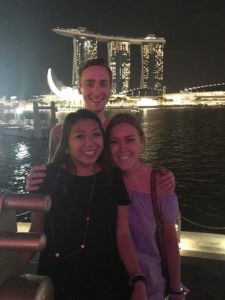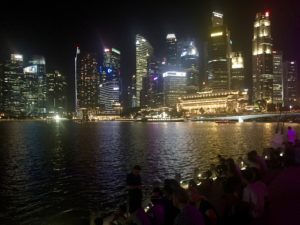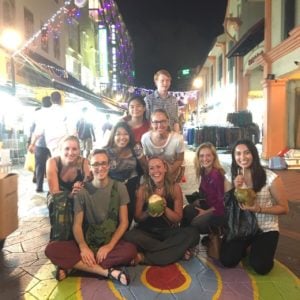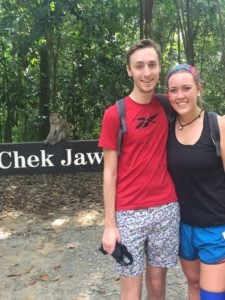07 Jun A Bulldawg in the Lion City
Sam Varie from Butler University shares his current experience working for a Non-profit organization in Singapore as one of Absolute’s Summer 2017 Intern Heroes
Prior to arrival in Singapore, I expected wealth, cleanliness and most of all, humidity. I figured the wealth to be similar to what I see in the wealthy areas of my city, the humidity to be no worse than Indiana summers and, well, a clean city was definitely a new concept to me. The reality of these three pre-conceived notions was totally different to what I experienced.
Stepping off the plane, my glasses immediately fogged up and I realized that Singapore humidity was so much worse than Indiana. It was instantly suffocating. After struggling with customs and attempting to manage both my suitcase and 70L backpack, we jumped into a Mercedes van, and made our way to our residence. This was when the magnitude of wealth hit me. BMWs, Mercedes, Porches, Bentleys and Ferraris surrounded us going down the highway. While we may see these cars regularly in America, let me put its significance into context. First, Singapore is a very eco-friendly and congested island. Therefore, cars are discouraged and public transportation is made readily available. To discourage use the government has made owning a car prohibitive. The required license/certificate to drive a car costs S$90,000 (US$65,000). Just the license. Then, a hefty tax is imposed, causing dealerships to increase car prices to cover the government regulated taxes. An “inexpensive car” costs approximately S$100,000 (US$72,000). But that is a Honda, Toyota or a Mazda. A luxury car is well beyond that price. So, in Singapore, when you see a luxury car you are looking at unparalleled wealth, wealth that is rarely seen in my city or across America.

The cleanliness of the city was also instantly recognizable. We drove from the airport on the outskirts of the city into the heart of Singapore. There was not a single cigarette butt, empty cup, Coke can or carry-out box on the streets or sidewalk. Not only are the streets pristine, but so are the MRT, the buses, the food courts and even the public bathrooms. In fact, garden hoses are kept in all bathrooms so they get hosed down every night. Singaporeans set my Grammy’s standard of clean to a whole new level.
For the first few days we settled in and got to know the city. We toured the business district, took pictures with the Merlion and at Marina Bay Sands and ate well in Chinatown and Little India. Each day, our expectations of seeing great wealth, clean streets and sweat dripping from our face were a reality. On the first day of my internship, however, I saw a new side of Singapore. A side that highlights a lion-sized gap between what we saw while touring the city and what the vast majority of Singaporeans experience every day.
 Marina Bay Sands & Singapore Central Business District
Marina Bay Sands & Singapore Central Business District
During my internship training, I learned the a new side of Singapore. The first thing I was told was “the rich may be rich, but the poor are poorer.” In order to be classified as poor and receive aid from the government, a citizen must make less than $10 per day. Those who are making $10.01 or more each day however, are left with an impossible lifestyle. Ten dollars and one cent to cover transportation, food, medical, water, electricity and rent. It’s impossible to survive on $10 per day in most cities, let alone Singapore, the most expensive city in the world. It is leaving those who make less than $10 a day in survival mode even with the government aid they receive.
My colleague then explained to me that Singapore has an overwhelmingly senior population. The number of elderly individuals heavily outweighs the youth due to reproduction bans the government established and then repealed years ago. Because of a large elderly population, Singapore has an increased need for access to healthcare facilities, leaving many unable to receive any help in times of illness.
 Little India
Little India
Finally, Singapore does not have services for individuals who are facing both mental and physical disorders. This causes these individuals to only receive partial treatment or no treatment at all. More depressingly, these individuals cannot work, leaving them with no income. Luckily for some, they have families to look after them. Those who do not have families become “homeless.” In Singapore, no one lives on the streets. The government places all homeless citizens into a rental apartment and helps ease them back into society through the Ministry of Social and Family Development. While it is beneficial to provide housing and resources, the homeless and needy are invisible.
 Hanging with monkeys at Pulau Ubin
Hanging with monkeys at Pulau Ubin
With a multitude of problems to be addressed, my employer has stepped in to create Community Resilience programs. These programs work to combat the gap between the vulnerable and the disadvantaged Singaporeans not receiving government aid and those who can survive on their own. My employer works to shrink the gap through programs where food is delivered once a month to the needy; or providing a 24/7 care facility for the those with mental and physical disorders; or a program to link the elderly with volunteers to ensure they have social opportunities and referral to aid when needed.
My experience at my internship has allowed me to see to see the real Lion City: both the advantaged and the vulnerable. Within days of arrival, my understanding of Singapore went from a city of wealth, clean streets and humid air, to a city that has disadvantaged people who are invisible to the tourist’s eye. I feel incredibly lucky to be at company where each person is working to close the gap to improve the lives of the disadvantaged.


No Comments